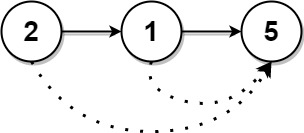原文链接: https://leetcode-cn.com/problems/next-greater-node-in-linked-list
英文原文
You are given the head of a linked list with n nodes.
For each node in the list, find the value of the next greater node. That is, for each node, find the value of the first node that is next to it and has a strictly larger value than it.
Return an integer array answer where answer[i] is the value of the next greater node of the ith node (1-indexed). If the ith node does not have a next greater node, set answer[i] = 0.
Example 1:

Input: head = [2,1,5] Output: [5,5,0]
Example 2:

Input: head = [2,7,4,3,5] Output: [7,0,5,5,0]
Constraints:
- The number of nodes in the list is
n. 1 <= n <= 1041 <= Node.val <= 109
中文题目
给出一个以头节点 head 作为第一个节点的链表。链表中的节点分别编号为:node_1, node_2, node_3, ... 。
每个节点都可能有下一个更大值(next larger value):对于 node_i,如果其 next_larger(node_i) 是 node_j.val,那么就有 j > i 且 node_j.val > node_i.val,而 j 是可能的选项中最小的那个。如果不存在这样的 j,那么下一个更大值为 0 。
返回整数答案数组 answer,其中 answer[i] = next_larger(node_{i+1}) 。
注意:在下面的示例中,诸如 [2,1,5] 这样的输入(不是输出)是链表的序列化表示,其头节点的值为 2,第二个节点值为 1,第三个节点值为 5 。
示例 1:
输入:[2,1,5] 输出:[5,5,0]
示例 2:
输入:[2,7,4,3,5] 输出:[7,0,5,5,0]
示例 3:
输入:[1,7,5,1,9,2,5,1] 输出:[7,9,9,9,0,5,0,0]
提示:
- 对于链表中的每个节点,
1 <= node.val <= 10^9 - 给定列表的长度在
[0, 10000]范围内
通过代码
高赞题解
解题思路:
因为 vector 支持扩容,所以可以直接一边扫描一边 push_back 直接实现,基础为栈,思路比较简单
我的栈中存储的是元素的 val 和下标,每次出栈依靠下标去修改 vector 中的值,val 则用作比较大小
以示例 $2$ 为例:[2,7,4,3,5]
 {:width=550}
{:width=550}
{:align=center}
[-cpp]class Solution { public: vector<int> nextLargerNodes(ListNode *head) { int count = 0; //计数,作为下标 vector<int> result; stack<pair<int, int>> tmp; //first为val,second为下标 while (head) { result.push_back(0); //给result数组后面+0,1为保证长度,2是默认值(后无更大的值的话)为0 while (!tmp.empty() && head->val > tmp.top().first) //栈不为空且head指针的val值大于栈顶的元素的值 { result[tmp.top().second] = head->val; //result数组修改,满足题意要求的最大值,然后出栈,继续循环 tmp.pop(); } tmp.push(make_pair(head->val, count++)); //count++计数 head = head->next; //下一个节点 } return result; } };
统计信息
| 通过次数 | 提交次数 | AC比率 |
|---|---|---|
| 21198 | 35309 | 60.0% |
提交历史
| 提交时间 | 提交结果 | 执行时间 | 内存消耗 | 语言 |
|---|




